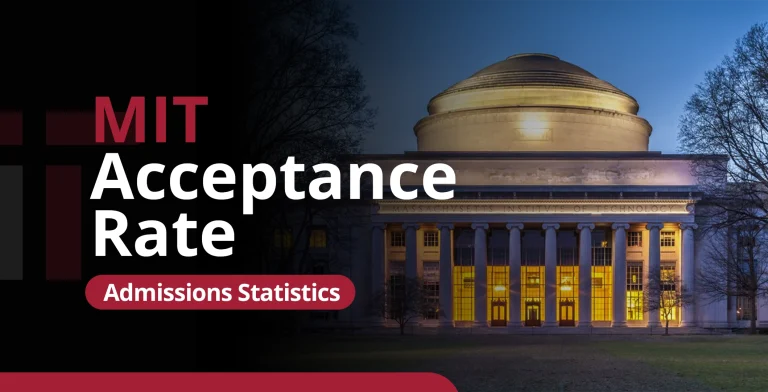With MIT’s acceptance rate for the Class of 2029 sitting at just 4.5%, you’re looking at one of the toughest universities to get into. While that 4.5% is pretty intimidating, knowing the numbers upfront can actually help you shape a stronger, more targeted application.
In this blog, we’re going to dig into MIT’s acceptance rates, what the trends look like, and—more importantly—what you can do to give yourself the best shot at getting in. Let’s break down what it takes to beat those odds.
- What Is MIT’s Acceptance Rate?
- MIT Acceptance Rate Trends
- MIT Regular Decision Acceptance Rate
- MIT Early Action Acceptance Rate
- How to Get Accepted into MIT
- MIT Transfer Acceptance Rate
- MIT Waitlist Acceptance Rate
- Frequently Asked Questions
- Takeaways
What Is MIT’s Acceptance Rate?
For the Class of 2029, the MIT acceptance rate stands at 4.5%. Let’s do the math: out of 29,282 applications, only 1,324 students made it through. The rate is virtually identical to the Class of 2028’s 4.5% acceptance rate.
Here’s how the Class of 2029 stats look when you break the numbers down by application type:
| Application Type | Total Applications | Accepted | Acceptance Rate |
| Regular Action (Regular Decision) | 17,229 | 603 | 3.5% |
| Early Action | 12,053 | 721 | 6% |
| Overall | 29,282 | 1,324 | 4.5% |
So, yes, applying early can give you a tiny edge, but don’t get too comfortable. It’s still incredibly competitive. Even with that slight bump, only the most outstanding applications make the cut. If you’ve got your heart set on MIT, you’ve got to bring your A-game—and then some.
MIT’s yield rate
Let’s talk about yield rate for a second. For the Class of 2028, MIT’s yield rate was a hefty 86%. Out of the 1,284 admitted students, 1,102 eventually enrolled. That’s a pretty clear sign that once students get that acceptance letter from MIT, they’re all in.
A yield rate like that shows just how sought-after MIT is. When students are turning down other elite schools to head to Cambridge, it’s pretty clear MIT’s reputation still holds serious weight among the brightest minds out there.
MIT Acceptance Rate Trends
Over the past decade, the MIT acceptance rate has taken a nosedive, making an already tough admissions process even more competitive. Here’s a glimpse into how things have shifted over the years:
| MIT Class | Total Applications | Overall Acceptance Rate |
| 2029 | 29,282 | 4.5% |
| 2028 | 28,232 | 4.5% |
| 2027 | 26,914 | 4.7% |
| 2026 | 33,767 | 3.9% |
| 2025 | 33,240 | 4% |
| 2024 | 20,075 | 7.3% |
| 2023 | 21,312 | 6.6% |
| 2022 | 21,706 | 6.7% |
| 2021 | 20,247 | 7.1% |
| 2020 | 19,020 | 7.8% |
If you look at the numbers, it’s pretty clear: back in the Class of 2020, MIT’s acceptance rate was around 7.8%. Fast forward to the Class of 2029, and it’s down to just 4.5%. More people are applying, yes, but it’s also a sign that MIT’s becoming even pickier about who makes the cut.
A big spike happened with the Class of 2025, when applications shot up to over 33,000. Why? The pandemic led MIT to go test-optional, which drew in more hopefuls. But despite testing coming back, the number of applications stayed high, and the acceptance rate still hovers below 5%.
So, what’s driving this ultra-competitiveness? Well, it’s MIT’s rock-solid reputation in STEM, cutting-edge research, and killer career prospects. Basically, if you’re aiming for a spot, you’re up against thousands of other high-achievers with the same dream.
MIT’s acceptance rate vs Ivy League
MIT isn’t technically in the Ivy League, but when it comes to the MIT acceptance rate, it’s playing in the same league as those top Ivies. As some Ivy League schools haven’t released their Class of 2029 stats yet, we’ll use the Class of 2028 acceptance rates for comparison instead:
| Ivy League School | Acceptance Rate (Class of 2028) |
| Harvard University | 3.6% |
| Yale University | 3.7% |
| Columbia University | 3.85% |
| Princeton University | 4.6% |
| Brown University | 5.2% |
| Dartmouth College | 5.3% |
| University of Pennsylvania | 5.4% |
| Cornell University | 8.4% |
MIT’s rate is lower than five of the Ivies, and just a hair above Harvard, Yale, and Columbia. That’s why MIT is often seen as a “Hidden Ivy.” The bottom line? If you’re gunning for MIT, you’ll need a rock-solid academic profile, impressive extracurriculars, and that something special to set you apart from other brilliant applicants.
MIT Regular Decision Acceptance Rate
MIT calls its Regular Decision (RD) process “Regular Action,” and if you’re thinking of going this route, it won’t be an easy ride. For the Class of 2029, MIT’s RD acceptance rate was just 3.5%. Out of a pool of 17,229 applications, only 603 students made the cut. That’s even lower than MIT’s overall acceptance rate of 4.5% and significantly below the Early Action (EA) rate, which sits at 6%.
If you look at the past decade, it’s clear that MIT’s Regular Action acceptance rate has been on a steady decline:
| MIT Class | Total Regular Action (Regular Decision) Applications | Regular Action (Regular Decision) Acceptance Rate |
| 2029 | 17,229 | 3.5% |
| 2028 | 15,669 | 3.9% |
| 2027 | 14,990 | 3.8% |
| 2026 | 19,195 | 3.3% |
| 2025 | 18,204 | 3.4% |
| 2024 | 10,784 | 7.1% |
| 2023 | 11,712 | 6% |
| 2022 | 12,149 | 6.6% |
| 2021 | 11,853 | 6.6% |
| 2020 | 11,253 | 7.4% |
Back in the Class of 2020, MIT’s RD acceptance rate was hovering around 7.4%, but for recent classes, it’s barely reaching 4%. The spike in competition really kicked off around the Class of 2025 when more students started applying, especially after MIT went test-optional during the pandemic. And while the RD acceptance rate has always been tough, it’s now even tougher as MIT gets increasingly selective.
Here’s what that means for you: if you’re applying RD, you’ve got to be prepared to go all out. While applying EA might give you a slight boost, it still requires an impressive, all-around stellar application to even stand a chance.
MIT Regular Decision deadline and notification date
If you’re set on applying through MIT’s RD, don’t miss that January 6 deadline. You’ll hear back by mid-March, giving you some time to figure out your next steps. And if you’re lucky enough to get that acceptance letter, you’ll need to commit by May 1.
Make sure to stay on top of these dates and get your application ready well ahead of time. The competition is fierce, so the last thing you want is to scramble at the eleventh hour.
MIT Early Action Acceptance Rate
If you’re thinking of applying to MIT, the Early Action (EA) option might just give you a slight—but very slight!—leg up. For the Class of 2029, the MIT acceptance rate for EA is 6%. Out of 12,053 eager applicants, only 721 got the nod. That’s a bit better than the Regular Decision (RD) rate of 3.5% and the overall acceptance rate of 4.5%.
Here’s how MIT’s EA acceptance rates have shifted over the past decade:
| MIT Class | Total Early Action Applications | Early Action Acceptance Rate |
| 2029 | 12,053 | 6% |
| 2028 | 12,563 | 5.3% |
| 2027 | 11,924 | 5.7% |
| 2026 | 14,781 | 4.7% |
| 2025 | 15,036 | 4.8% |
| 2024 | 9,291 | 7.4% |
| 2023 | 9,600 | 7.4% |
| 2022 | 9,557 | 7% |
| 2021 | 8,394 | 7.8% |
| 2020 | 7,767 | 8.5% |
For the Class of 2020, the acceptance rate was sitting at a friendlier 8.5%. Fast forward to the Class of 2029, and it’s been whittled down to just 6%. More students are trying to get a head start by applying early, which only makes the competition fiercer. Even with that slight edge, you’re still up against some of the brightest minds out there.
Take note: MIT’s EA is non-binding. So, if you get in, you’re not locked into attending. You’re also free to apply to other schools simultaneously—as long as they don’t have restrictive EA policies. This flexibility gives you some breathing room to explore other options if MIT doesn’t pan out or if you just want to keep your choices open.
MIT Early Action deadline and notification date
Thinking about going for MIT’s EA? You’ll need to have everything wrapped up by the November 1 deadline. Decisions typically roll out by mid-December. If you’re lucky enough to get that acceptance letter, you’ll have until May 1 to make it official.
Why apply early? You’ll find out the results sooner, which can take some of the edge off that waiting game. But your application needs to be polished and ready to go well before that deadline if you want to really stand out. So, plan ahead, get everything in order, and hit that submit button with confidence.
How to Get Accepted into MIT
If you’re aiming for MIT, you won’t be going the Common App or Coalition App route. Instead, MIT has its very own application portal. You can review MIT’s first-year admission requirements to ensure your application meets all the necessary criteria. Once you create an account, you’ll handle everything through that portal—from submitting your application to tracking its status and even making updates if needed
MIT’s admissions process is holistic, which means they’re looking beyond just your grades. They’re interested in your personal qualities, extracurriculars, and essays. To have a shot, you’ll need to nail every part of the application:
Target GPA
MIT doesn’t officially state a minimum GPA, but the competition is fierce. Most students who get in have nearly flawless academic records, averaging around a 4.2 (weighted). In other words, you’re looking at mostly straight A’s in tough classes like AP, IB, or honors courses.
Admissions officers want to see that you’ve challenged yourself with a rigorous course load. If your GPA is a tad below that average, don’t panic. You can still stay in the game by crushing it in other areas, like test scores or showcasing impressive achievements.
Target test scores
MIT requires standardized test scores. According to MIT’s latest Common Data Set (2023-2024), admitted students tend to score high:
- For the SAT, the 25th percentile score is around 1520, the median is 1550, and the 75th percentile is 1570.
- As for the ACT, the 25th percentile is about 34, the median is 35, and the 75th percentile is 36.
So, if you’re aiming for MIT, you want to be in that upper range—think 1570+ on the SAT or a perfect 36 on the ACT. While high scores alone won’t guarantee you a spot, they can definitely boost your application, especially if your GPA isn’t quite where you want it.
Other requirements
Let’s get one thing straight: having great grades and scores is just the start. MIT wants students who are curious, driven, and passionate about what they do, especially in STEM fields. Here’s how to stand out:
- Extracurriculars. MIT isn’t impressed by a laundry list of activities. They’d rather see deep commitment to a few interests. Compete in science fairs, build cool coding projects, or volunteer in your community. Show them how you’ve made an impact and grown through those activities.
- Essays. MIT requires you to write five short essays. This is your moment to show who you are beyond your grades and scores. Be genuine, thoughtful, and reflective. They want to know how you think, solve problems, and connect with your community.
- Recommendation letters. MIT asks for three letters: two from teachers and one from your school counselor. Ideally, they want one letter from a math or science teacher and the other from someone in humanities or social sciences. These letters should highlight your character, work ethic, and intellectual curiosity.
For more details on how to ace each part of your MIT application, check out our in-depth guide on how to get into MIT.
MIT Transfer Acceptance Rate
If you think getting into MIT as a freshman is tough, trying to transfer in might just be a whole new level of competitive. The latest numbers from MIT’s Common Data Set (2023-2024) tell the story: out of 1,223 transfer applicants, only 23 got accepted, which brings the MIT transfer acceptance rate down to a mere 1.9%. To put that in perspective, the first-year acceptance rate sits at 4.5%, which already feels like a long shot.
Why is it so hard? Well, MIT is laser-focused on admitting transfer students who’ve not only excelled academically but also show they’re a perfect fit for MIT’s intense academic culture. Unlike first-year hopefuls, transfer students are expected to come in ready to hit the ground running. That means having done some serious coursework in your chosen major already and proving you can thrive in MIT’s uniquely challenging curriculum right away.
Given how tiny the transfer acceptance rate is, you’ll need near-perfect grades, stellar recommendations, and a track record of impressive achievements at your current school. And you’ve got to show that you’ve made the most of your time where you are now and are fully geared up for the academic intensity that MIT demands.
MIT Waitlist Acceptance Rate
For the 2023-2024 cycle (Class of 2027), MIT waitlisted 619 students, and 558 of them chose to stick around on the list. Out of those, only 32 were eventually admitted, giving the waitlist acceptance rate a slim 5.7%. But for the Class of 2028, it was even tighter—just about 1.5%, with only 9 out of 590 students making the cut.
Waitlist acceptance rates at schools like MIT are famously unpredictable. Whether or not they dip into the waitlist pool depends entirely on how many accepted students actually decide to enroll. In some years, MIT might admit a few folks from the waitlist; in other years, zero.
If you find yourself waitlisted, don’t lose hope just yet. Here’s how you might improve your chances:
- Send a letter of continued interest (LOCI). Reach out to let MIT know that you’re still really interested in joining. Be specific about why MIT is your top choice and what excites you about their programs.
- Provide meaningful updates. If you’ve won awards, aced some courses, or gotten involved in new projects since you submitted your application, now’s the time to let MIT know. Show them you’ve kept pushing yourself even after applying.
- Stay realistic. Being on the waitlist means you’re not out of the game yet, but it’s definitely a long shot. Given how low the MIT acceptance rate is for waitlisted students, it’s smart to keep exploring your other options.
While there’s no magic formula, showing your ongoing enthusiasm and highlighting your latest achievements might just tip the scales in your favor—if a spot happens to open up.
Frequently Asked Questions
1. What is MIT’s latest overall acceptance rate for the Class of 2029?
For the Class of 2029, the MIT acceptance rate sits at 4.5%. Out of a pool of 29,282 applicants, just 1,324 made the cut.
2. What is MIT’s Early Action acceptance rate?
MIT’s Early Action route saw a slightly higher acceptance rate at 6%. Of the 12,053 students who applied early, 721 were admitted.
3. What is MIT’s Regular Decision acceptance rate?
When it comes to MIT’s Regular Action round, the acceptance rate drops to 3.5%. MIT admitted 603 students out of 17,229 applications.
4. What is MIT’s transfer acceptance rate?
Getting in as a transfer student is even tougher. For the 2023-2024 cycle, only 23 out of 1,223 applicants were admitted, which means the MIT transfer acceptance rate is a mere 1.9%.
5. What is MIT’s waitlist acceptance rate?
The waitlist can be a bit of a gamble. For the Class of 2028, 590 applicants were offered a waitlist spot, but only 9 were eventually admitted, bringing the waitlist acceptance rate down to 1.5%.
Takeaways
Here are five key takeaways to help you understand MIT’s acceptance rate and boost your chances of getting in:
- For the Class of 2029, MIT’s acceptance rate stands at 4.5%. That’s a clear indicator of just how selective the school is. You’re up against some serious competition here.
- MIT’s acceptance rate is on par with heavyweights like Ivy League schools. If you’re aiming for MIT, you’re definitely in for a challenge.
- Going for Early Action gives you a slight edge, with a 6% acceptance rate. In contrast, those applying through Regular Action face steeper odds at just 3.5%. It’s not a huge difference, but every bit helps when the stakes are this high.
- You’ll need an academic profile that’s basically flawless. Think a GPA of 4.2, an SAT score hovering around 1570, or a perfect 36 on the ACT. But your essays, recommendations, and extracurriculars need to shine just as bright.
- Let’s be real—MIT’s acceptance rate is super tough. This is where a college admissions consultant can step in to fine-tune your strategy and help you craft a standout application that aligns with what MIT is looking for.

Eric Eng
About the author
Eric Eng, the Founder and CEO of AdmissionSight, graduated with a BA from Princeton University and has one of the highest track records in the industry of placing students into Ivy League schools and top 10 universities. He has been featured on the US News & World Report for his insights on college admissions.












